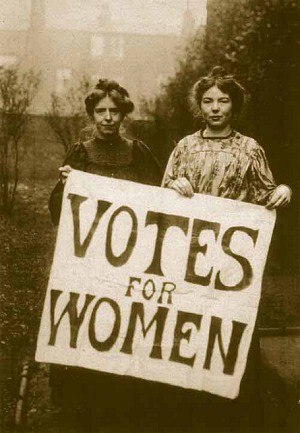Articles
- The 20th century
- Key events
- Making sense of the tangible world
- Health and Welfare
- Space exploration
- Scientific advancement: computers, technology & textiles
- Monarchy
- Democracy & social mobility
- Transport and leisure
- Colonialism & post-colonialism
- Sexuality, marriage, parenthood & divorce
- Income & consumerism
- Humans and the environment
- Educational context
- Mass culture & entertainment
- The world of work
- Making sense of the intangible world
Feminism
What is feminism?SuffrageEmploymentMore opportunitiesGradual acceptanceContraception and fertilityChallenge to patriarchyThe feminist movementEquality?
What is feminism?
Feminism is the belief that women should have the same rights as men. It encompasses the spheres of politics, economics, education, employment, as well as cultural and social attitudes and personal rights. It is a reaction to the inequality engendered by historically entrenched patriarchies. Over the twentieth century feminism in Britain resulted in huge social changes.
Suffrage
 At the start of the twentieth century, British women were not allowed to vote. In the later years of the nineteenth century, various groups had developed in order to win the right for women to vote. They believed that, if women could have a say in the democratic process, they would be able to influence politicians to pass laws to improve women's rights.
At the start of the twentieth century, British women were not allowed to vote. In the later years of the nineteenth century, various groups had developed in order to win the right for women to vote. They believed that, if women could have a say in the democratic process, they would be able to influence politicians to pass laws to improve women's rights. Some protests were peaceful. Others, most famously those carried out by the Suffragettes, were more violent. They included smashing windows, pouring acid in post boxes and slashing paintings in art galleries.
These activities ceased on the outbreak of the First World War, in which women played a major role, maintaining essential industries whilst men were called up to fight. In 1918, partly as a reward for their contribution to the war effort, women over 30 were given the right to vote. In 1928, this right was extended to women over 21, the same as male voters.
Employment
More opportunities
Before the twentieth century, many women from the lower socio-economic classes had to work in order to supplement their husbands' low wages. By the start of the twentieth century, new forms of employment had become available for 'respectable' women. These included:
- Office work, often using the newly-invented typewriter
- Nursing
- Teaching
- Sales assistants in the new department stores.
However, women were usually less well paid than men and they were excluded from professional jobs, such as being a solicitor, an accountant or a Member of Parliament.
Most of the women who did jobs vacated by men during the First World War were disappointed to have to give them up once the men came home. From the 1920s onwards, the spread of inventions such as vacuum cleaners and washing machines meant that women's work in the home became easier, gradually releasing women to pursue paid employment opportunities. More and more women took on part-time and full-time jobs, although these were often unskilled. It was assumed that women would leave employment once married, and certainly once they became mothers.
Gradual acceptance
Women again played a vital role in the Second World War and, gradually, women were accepted in all the main professions. However, women were expected to give up their jobs in favour of their returning men-folk after the War and the 1950s promoted the importance of female domesticity.
In the decades following the Second World War, there was growing dissatisfaction that working women were not treated as equal with their male colleagues. In 1970, an Equal Pay Act was passed, guaranteeing women the same pay and working rights as men. This was followed by the 1975 Sex Discrimination Act. These marked a significant improvement in women's rights, but did not, in practice, create full equality.
Contraception and fertility
At the start of the twentieth century, there was widespread ignorance about methods of contraception. The Roman Catholic Church taught that any artificial method of preventing conception was immoral. Partly because of this and partly because so many children died in infancy, family sizes were often large. It was not uncommon for couples to have ten or more children. Many women's health suffered because of this, and it also severely restricted their freedom to seek paid employment.
Towards the end of the nineteenth century, a birth control movement developed. It sought to educate people about the importance of family planning, using birth control methods. In 1921, the first permanent birth control clinic was set up in the United Kingdom by Marie Stopes. This clinic helped to make contraception acceptable by presenting it in scientific terms. In 1930, the Ministry of Health allowed local authorities to give birth control advice in welfare centres.
 In 1961 the contraceptive pill became publicly available, although initially it was only prescribed to married women who had already had children and did not want to increase the size of their families. The Pill gave women unprecedented control over their fertility, allowing them to plan the number and timing of their children around their career aspirations.
In 1961 the contraceptive pill became publicly available, although initially it was only prescribed to married women who had already had children and did not want to increase the size of their families. The Pill gave women unprecedented control over their fertility, allowing them to plan the number and timing of their children around their career aspirations.Challenge to patriarchy
At the start of the twentieth century, British society was dominated by men:
Women could not vote, let alone become Members of Parliament
They were excluded from many professions
In the home, they were subject to the authority of their husband.
A number of factors contributed to changing this situation:
- The granting to women of the right to vote meant that politicians could no longer ignore women's interests. The first female Member of Parliament was elected in 1919 and, by the end of the twentieth century, around 20% of MPs were women
- The vital role played by women in both world wars helped to undermine any prejudice that they were inferior performers in the workplace
- The invention of labour-saving gadgets in the home and the availability of more effective birth control methods gave them greater freedom to seek employment and pursue a lifelong career.
The feminist movement
In the late 1960s and 1970s the ‘feminist movement’ became a more significant force within society, with prominent advocates and written texts inspiring a change in attitude amongst women themselves. They were empowered to assert control over their education and career, their personal appearance and sexual availability, their right to be regarded as individuals rather than adjuncts to men.
The English language became far more ‘gender-neutral’, reflecting the assumption that females were capable of all that males could achieve. ‘Firemen’ became ‘fire-fighters’; ‘chairmen’ became ‘chair persons’. Britain’s first female Prime Minister was appointed in 1979.
Equality?
By the end of the century, even if full equality had not been achieved, great progress had been made. Women had reached the top tiers of academia, in major companies and in the professions. Their contribution to the economy had vastly increased. In the home environment, there was a greater emphasis on the two genders working as partners, rather than the male being dominant.
A term applied to British women activists campaigning for the right to vote.
World War I, also know as the First World War and the Great War, was a global conflict from 1914 – 1918, centred in Europe, involving all the world’s major economic powers in two opposing alliances.
Offficially ordered to report for military service, usually via a posted notification.
The global war which lasted from 1939 – 1945
A worldwide Christian church which traces its origins from Peter, one of the disciples of Jesus. It has a continuous history from earliest Christianity. Its centre is the Vatican Palace, Rome, where the Pope resides.
Recently Viewed
-
Feminism
now
